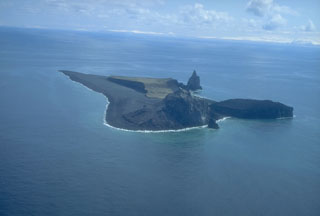Report on Bogoslof (United States) — 8 March-14 March 2017
Smithsonian Institution / US Geological Survey
Weekly Volcanic Activity Report, 8 March-14 March 2017
Managing Editor: Sally Sennert.
Please cite this report as:
Global Volcanism Program, 2017. Report on Bogoslof (United States) (Sennert, S, ed.). Weekly Volcanic Activity Report, 8 March-14 March 2017. Smithsonian Institution and US Geological Survey.
Bogoslof
United States
53.93°N, 168.03°W; summit elev. 150 m
All times are local (unless otherwise noted)
AVO reported that an explosive event at Bogoslof began at about 2236 on 7 March, indicated in seismic, lightning, and infrasound data, and lasted about three hours. Though ash was not immediately visible in satellite data, AVO raised the Aviation Color Code (ACC) to Red and the Volcano Alert Level (VAL) to Warning. Later, satellite images showed a large ash cloud rising to an altitude of 10.7 km (35,000 ft) a.s.l. and drifting E. This event was the first detected eruptive activity since 19 February, and more than 1,000 lightning strokes related to the volcanic eruption cloud were detected during this event, by far the highest number observed to date. In addition the seismic levels were among the highest detected since the beginning of the eruption. Satellite images from 8 March showed that the W part of the island had grown significantly. The ACC was lowered to Orange and the VAL was lowered to Watch on 9 March.
Two earthquakes swarms were detected during 9-11 March; the first began at 1750 on 9 March and ended at 1400 on 10 March, and the second was detected from 1900 on 10 March to 0500 on 11 March. Mildly elevated surface temperatures were identified in satellite data during 10-11 March. A third swarm began at 0500 on 12 March. A short-duration event, from 1131 to 1143 on 13 March, produced a small ash cloud that rose to an altitude of 5.5 km (18,000 ft) a.s.l. and drifted SSW. AVO noted that after the event, the level of seismic activity declined and the repeating earthquakes, detected for much of the previous several days, stopped. Weakly elevated surface temperatures were observed in two satellite images from 13 March. A photograph taken by a pilot showed a low-level, billowy steam plume rising from the general area of the intra-island lake.
Geological Summary. Bogoslof is the emergent summit of a submarine volcano that lies 40 km N of the main Aleutian arc. It rises 1,500 m above the Bering Sea floor. Repeated construction and destruction of lava domes at different locations during historical time has greatly modified the appearance of this "Jack-in-the-Box" volcano and has introduced a confusing nomenclature applied during frequent visits by exploring expeditions. The present triangular-shaped, 0.75 x 2 km island consists of remnants of lava domes emplaced from 1796 to 1992. Castle Rock (Old Bogoslof) is a steep-sided pinnacle that is a remnant of a spine from the 1796 eruption. The small Fire Island (New Bogoslof), about 600 m NW of Bogoslof Island, is a remnant of a lava dome formed in 1883.
Source: US Geological Survey Alaska Volcano Observatory (AVO)

